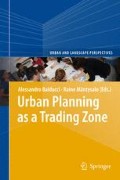Abstract
This chapter presents the case of a neighbourhood regeneration programme. It focuses on the experience of Ponte Lambro, a neighbourhood of 4,000 people in the south-east of Milan. The programme, started in 2006, is ongoing. It has accomplished the renovation of the social housing stock and public facilities, the creation of new housing units and the improvement of green spaces.
In order to support the programme, Milan City Hall established a Neighbourhood Lab tasked with the promotion of public participation, building communication channels, coping with the difficulties that change might create and informing local community about the development of the programme. Both authors, as appointed consultants, have been responsible for the management of the Lab.
Five years into the regeneration programme, it is possible to interpret the life of the laboratory as a trading zone’s building process that passed through different stages along its development.
This chapter describes the evolution of the laboratory according to the prototype conditions formulated by Collins et al.
The laboratory began work in a situation of lack of communication, of distrust between the local authority and residents and of great heterogeneity in terms of cultures, languages and forms of knowledge. It tried to encourage the collaboration, presenting the regeneration programme as a “boundary object”, a space of opportunity to fill in with projects by different actors. The laboratory made a great effort to translate technical languages for the residents, to build mutual trust and to create a sense of ownership of the programme. As a result, an “interactional expertise” has emerged.
In the final section, the chapter tries to answer to more generic questions: under which conditions can this case be a lesson for other similar situations, and to what extent can the TZ theory be useful to interpret how an integrated urban approach really works?
Access this chapter
Tax calculation will be finalised at checkout
Purchases are for personal use only
References
Briata P, Bricocoli M, Tedesco C (2009) Città in periferia. Carocci, Roma
Cognetti F (2009) Accanimento terapeutico. In: Laboratorio Città Pubblica (ed) Città pubbliche. Linee guida per la riqualificazione urbana. Bruno Mondadori, Milano, pp 111–112
Collins H, Evans R, Gorman M (2007) Trading zones and interactional expertise. Stud Hist Philos Sci 38(4):657–666
Commission of the European Communities – Directorate-General for Regional Policy (2009) Promoting sustainable urban development in Europe. Achievements and opportunities. European Communities, Brussels
Coppola A (2010) Gratosoglio: esercizi di trasformazione sulla città pubblica. In: Bricocoli M, Savoldi P (eds) Milano downtown. Et Al. edizioni, Milano, pp 105–131
Cremaschi M (2008) Limiti e prospettive dell’azione locale. Territorio 46:85–88
Cremaschi M (2010) Politiche, città, innovazione. Donzelli, Roma
Fareri P (2010) Rallentare. Franco Angeli, Milano
Galison P (1997) Image and logic: a material culture of microphysics. University of Chicago Press, Chicago
Galison P (2010) Trading with the enemy. In: Gorman M (ed) Trading zones and interactional expertise: creating new kinds of collaboration. MIT Press, Cambridge, pp 25–52
Hall P (1980) Great planning disasters. University of California Press, Berkeley
Laino G (2001) Condizioni per l’efficacia dei programmi di riqualificazione nell’ottica dello sviluppo locale. Archivio di studi urbani e regionali 70:137–165
Magatti M (ed) (2007) La città abbandonata. Dove sono e come cambiano le periferie italiane. Il Mulino, Bologna
Ministero delle Infrastrutture e dei Trasporti – Direzione generale delle aree urbane e dell’edilizia residenziale (2001) Contratti di Quartiere. Programmi per la riqualificazione di insediamenti urbani degradati. Edilizia Popolare, Roma
Palermo PC (2009) I limiti del possibile. Donzelli, Roma
Pasqui G (2011) Un ciclo politico al tramonto. Perché l’innovazione delle politiche urbane in Italia ha fallito. Territorio 57:147–156
Rittel H, Webber M (1973) Dilemmas in a general theory of planning. Policy Sci 4(2):155–169
Savini F (2010) The endowment of community participation: institutional settings in two urban regeneration projects. Int J Urban Regional Res 35(5):949–968
Star SL, Griesemer JR (1989) Institutional ecology, ‘translations’ and boundary objects: amateurs and professionals in Berkley’s museum of vertebrate zoology, 1907–39. Soc Stud Sci 19(3):387–420
Tosi A (2006) Povertà e domanda sociale di casa: la nuova questione abitativa e le categorie delle politiche. La Rivista delle politiche sociali 3:61–78
Author information
Authors and Affiliations
Corresponding author
Editor information
Editors and Affiliations
Rights and permissions
Copyright information
© 2013 Springer Science+Business Media Dordrecht
About this chapter
Cite this chapter
Calvaresi, C., Cossa, L. (2013). A Neighbourhood Laboratory for the Regeneration of a Marginalised Suburb in Milan: Towards the Creation of a Trading Zone. In: Balducci, A., Mäntysalo, R. (eds) Urban Planning as a Trading Zone. Urban and Landscape Perspectives, vol 13. Springer, Dordrecht. https://doi.org/10.1007/978-94-007-5854-4_6
Download citation
DOI: https://doi.org/10.1007/978-94-007-5854-4_6
Published:
Publisher Name: Springer, Dordrecht
Print ISBN: 978-94-007-5853-7
Online ISBN: 978-94-007-5854-4
eBook Packages: EngineeringEngineering (R0)

